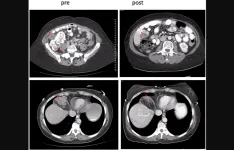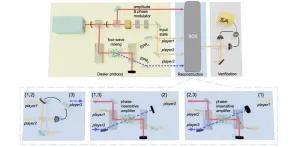(Press-News.org) A research team led by Dr Chaogu ZHENG from the School of Biological Sciences at The University of Hong Kong (HKU) has recently made a significant discovery about the evolutionary age of different type of cells in a small animal called Caenorhabditis elegans (C. elegans). By using single-cell transcriptomic data and refined phylostratigraphy, the team determines the transcriptomic age of individual cells, which means they are able to estimate the evolutionary origin of different cells based on the age of the genes expressed in the cells.
Their findings shed light on the cellular basis of the ‘hourglass’ pattern of animal development, revealing significant variation in the transcriptome age of different cell types. These results also provide insights into the varying contribution of different cells and tissues to adaptation, and the evolutionary relationship among cell types. These findings offer new perspectives on the genetic mechanisms that drive the evolution of species and have been published in the leading multidisciplinary journal PNAS.
Insights from Molecular Studies on Hourglass Model
The embryos of all animals share similar morphology at the middle stage of embryonic development while having larger morphological divergence at earlier and later stages. This pattern is often referred to as the ‘hourglass’ pattern of development, meaning that all animal development experiences an evolutionarily conserved phase during mid-embryogenesis.
Recent molecular studies have shown that embryos at the middle stage of embryogenesis express the oldest transcriptome, which means that the oldest and most conserved genes are used at this stage during gene expression. In contrast, younger genes are expressed in the earlier and later stages of embryonic development. This was discovered by analysing gene expression of the embryos in different developmental stages using a technique called phylostratigraphy, a method used to determine gene ages by comparing their sequences across different species.
However, these studies are limited in that they could only determine the transcriptome age of the entire organism throughout development but not in individual cells or tissue. This limitation is significant because obtaining information about the age of genes expressed in specific cells and tissue is crucial for gaining a more detailed understanding of the evolution of developmental patterns among species, as well as the genetic mechanisms driving it. Additionally, it can shed light on how individual tissue and cells contribute to the ‘hourglass’ pattern, which is a crucial aspect of understanding how different organs and tissues contribute to the evolution and adaptation of the overall developmental process in animals.
From Whole-Organism to Single-Cell Analysis
To fill this knowledge gap, the research team studies the transcriptome age of the nematode C. elegans at the single cell level using RNA sequencing. They look at RNA expression from both whole embryos (or organism) and individual cells to gain a comprehensive understanding of how different genes are used during embryonic and larval development.
The team first identifies a period of the oldest transcriptome during C. elegans mid-embryogenesis, which starts after gastrulation, a process that forms different germ layers in the embryo and continues into the early development of an organ. More importantly, the research team finds that in early embryos, certain cells used older genes than other cells. For example, cells that would later become the germline (which is responsible for passing on genetic information to offspring) use older genes than somatic tissues in the body. Similarly, cells that would later become the endoderm (which gives rise to the digestive tract) use older genes compared to other cell types during early development. Among differentiated cells, muscles appear to have the oldest transcriptome than other cell types.
It is also observed that the variation in transcriptome ages among the cell and tissue types remain small in early embryonic stages and grow bigger at late embryonic and larval stages as cells differentiate. Tracking the dynamics of transcriptome age along lineages identifies certain tissues, such as the skin, that contribute to the rise of the transcriptome age in late embryos.
Further analysis of the variation in transcriptome ages among the 128 different types of neurons in C. elegans nervous system reveals that a specific group of chemosensory neurons and their downstream interneurons express very young transcriptomes, which may have contributed to adaptation in recent evolution, as many newly evolved young genes are associated with sensing environmental factors. Finally, by analysing the variation in transcriptome age among the different neuron types, as well as the age of the genes that regulate their development (fate regulators), the research team is able to hypothesize about the evolutionary history of some of these 128 neuron types.
‘Using C. elegans as an example, we showcase how the transcriptome age at the single-cell level can provide insight into the cellular basis of developmental innovation and help understand the functional diversity and evolutionary origin of cell types,’ said Dr Fuqiang MA, a Postdoctoral Fellow of HKU School of Biological Sciences and the first author of the paper.
Dr Zheng, the supervisor of the research project, highlighted that ‘this study serves as an example of using the cutting-edge single-cell transcriptomics to study old problems in evolutionary biology.’ Dr Zheng envisions that the possibility of determining the evolutionary age of individual cell types at the transcriptome level can open up new research directions and advance our understanding of the genetic mechanisms that drive the evolution of species.
About the research paper:
Ma F, Zheng C. Transcriptome age of individual cell types in Caenorhabditis elegans. Proc Natl Acad Sci U S A. 2023 Feb 28;120(9):e2216351120. doi: 10.1073/pnas.2216351120.
The journal paper can be accessed from here:
www.pnas.org/doi/10.1073/pnas.2216351120
This work is supported by funding from the National Science Foundation of China, the Research Grant Council of Hong Kong, and The University of Hong Kong.
Images download and captions: https://www.scifac.hku.hk/press
For media enquiries, please contact Ms Casey To, External Relations Officer (Tel: 3917-4948; email: caseyto@hku.hk) and Ms Cindy Chan, Assistant Communications Director of Faculty of Science (Tel: 3917-5286; email: cindycst@hku.hk).
END
HKU biologists determine the evolutionary age of individual cell types providing critical insights for animal development
2023-04-13
ELSE PRESS RELEASES FROM THIS DATE:
Coral-eating fish poo may act as ‘probiotics’ for reefs
2023-04-13
Until recently, fish that eat coral — corallivores — were thought to weaken reef structures, while fish that consume algae and detritus — grazers — were thought to keep reefs healthy. But scientists have discovered that feces from grazers leave large lesions on coral, possibly because they contain coral pathogens. By contrast, feces from corallivores may provide a source of beneficial microbes that help coral thrive.
“Corallivorous fish are generally regarded as harmful because they bite the corals,” said Dr Carsten Grupstra of Rice University, ...
New study demonstrates hospital safety climate and organizational characteristics predict healthcare-associated infections and occupational health outcomes
2023-04-13
Arlington, Va., April 13, 2023 – New data published today in the American Journal of Infection Control (AJIC) provide the first published evidence that a positive safety climate and adherence to standard precautions predict key healthcare-associated infection (HAI) and occupational health outcomes among patients and health care workers, respectively. The findings highlight features within hospitals’ organizations and safety climates that could be modified to improve these outcomes.
“Despite the infection prevention and safety benefits associated with standard precautions, generating consistent adherence in the healthcare setting has been ...
Selenium as a predictor of metabolic syndrome in middle age women
2023-04-12
“Recently, optimizing selenium intake in the population to prevent diseases [...] has been an important issue in modern health care worldwide.”
BUFFALO, NY- April 12, 2023 – A new research paper was published in Aging (listed by MEDLINE/PubMed as "Aging (Albany NY)" and "Aging-US" by Web of Science) Volume 15, Issue 6, entitled, “Selenium as a predictor of metabolic syndrome in middle age women.”
Metabolic syndrome (MetS) is a widespread clinical entity that has become almost a global epidemic. Selenium plays an important role in metabolic homeostasis. It has been suggested that it ...
A new vision for soybean meal: designer tempeh
2023-04-12
In a novel effort to create the next generation of plant-based, protein-rich environmentally sustainable and savory alternatives to animal meat, a University of Massachusetts Amherst food scientist has turned his attention to soybean meal.
Globally, this byproduct of soybean oil extraction is used almost exclusively for animal feed. In the U.S. alone, some 48 million metric tons of soybean meal was produced in 2022, according to the USDA.
“After the oil extraction, the majority of the protein is in the meal, not the oil,” says Hang ...
Riluzole and Sorafenib in patients with advanced solid tumors: a Phase I trial
2023-04-12
“Our phase I study determined the tolerable dose of this combination and investigated its biologic effects.”
BUFFALO, NY- April 12, 2023 – A new research paper was published in Oncotarget's Volume 14 on April 10, 2023, entitled, “A phase I trial of riluzole and sorafenib in patients with advanced solid tumors: CTEP #8850.”
Overexpression of metabotropic glutamate receptor 1 (GRM1) has been implicated in the pathogenesis of multiple cancers. Riluzole, an inhibitor of glutamate release, showed synergistic antitumor activity in combination with the multi-kinase inhibitor sorafenib ...
COVID-19 increased weekday screentime for children: study
2023-04-12
The COVID-19 pandemic led to increased weekday screentime for school-aged children says a new study involving the University of Ottawa published in JAMA Pediatrics.
Researchers examined the change in children’s screen time from prior to the pandemic to three separate pandemic waves between 2020 and 2021. Researchers found a boost of up to 1.35 hours per day during the weekdays compared to prior to the pandemic, particularly with school closures at the onset of the pandemic.
While the weekend time was on par with pre-pandemic levels, ...
In search of a better semiconductor chip
2023-04-12
A University of Texas at Arlington materials science and engineering researcher is working on a project to determine when failure happens in electronic device circuits. The research ultimately will help manufacturers design better semiconductor chips.
Choong-Un Kim, professor in the Department of Materials Science and Engineering, was awarded a $285,0000 grant from the Semiconductor Research Corporation (SRC) for the project “Enabling Electromigration Solver for Solder Joint With Various Packaging Structures and Alloys.” This is the latest in a series of grants he has received from SRC that aims to answer the demand for improved device reliability.
The SRC ...
All-optical quantum state sharing via continuous variable system
2023-04-12
Quantum information is a powerful technology for increasing the amount of information that can be processed and communicated securely. Using quantum entanglement to securely distribute a secret quantum state among multiple parties is known as “quantum state sharing.” An important protocol in quantum networks and cryptography, quantum state sharing works like this (in simple terms): a secret quantum state is divided into n shares and given to n players. The secret state can only be reconstructed ...
Father’s alcohol consumption before conception linked to brain and facial defects in offspring
2023-04-12
According to the U.S. Surgeon General, women should not drink alcoholic beverages during pregnancy because of the risk of birth defects in their unborn child. Now, research at Texas A&M University demonstrates that a father’s alcohol consumption before conception also links to growth defects that affect the development of his offspring’s brain, skull and face.
Research investigating fetal alcohol syndrome (FAS) exclusively examines maternal alcohol exposure. However, because men drink more and are more likely to binge drink than women, Dr. Michael Golding, an associate ...
New technique allows researchers to dig into molecular causes of pediatric bipolar disorder
2023-04-12
It’s extremely difficult to study the biological basis of psychiatric disorders, in part because researchers can’t easily collect brain cells from living people to study in the laboratory. Now, University of Utah Health scientists have developed a way around that.
The researchers grew three-dimensional structures, called “organoids”, derived from blood cells donated by a patient with pediatric bipolar disorder and by several family members. The approach identified significant molecular changes linked to the psychiatric condition.
The results, reported in Molecular Psychiatry, suggest that structural changes in the ...







